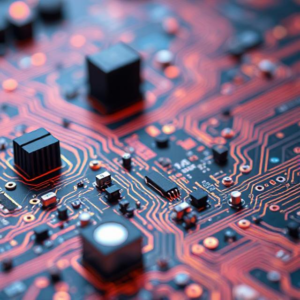1. What is Electronic Circuit Design?
Electronic circuit design is the process of creating circuits that make electronic devices work. A circuit is made up of components like resistors, capacitors, transistors, and more, which are connected together to perform specific tasks (like processing signals or powering a device).
For example, when designing a new smartphone or a piece of machinery, engineers need to create circuits that can handle the device’s specific functions.

2. What is AI in Circuit Design?
AI, in this case, refers to the use of machine learning and smart algorithms to help engineers design circuits faster, smarter, and more efficiently. It’s like having a super-smart assistant that can quickly analyze, suggest, and even improve parts of the design process.
3. How Does AI Help in Electronic Circuit Design?
Here are some ways AI is used:
A. Automated Design and Optimization
AI can quickly analyze existing designs and suggest improvements. Instead of manually tweaking every detail of a circuit, engineers can use AI tools to optimize it for performance, size, cost, and energy consumption. For example, if you want a circuit to use less power, AI might suggest adjustments to make it more efficient.
B. Speeding Up the Design Process
Designing circuits can take a lot of time. AI tools can speed this up by automatically generating parts of the design or testing different configurations quickly, allowing engineers to focus on the creative and critical parts of the work.
C. Predicting Performance and Problems
AI can simulate how a circuit will behave in real life before it’s even built. It can predict potential issues, like overheating or signal interference, and suggest fixes. This helps catch problems early and avoid costly errors during the manufacturing process.
D. Identifying Patterns and Trends
AI can look at thousands of previous designs and identify patterns that humans might miss. By analyzing lots of data, AI can suggest new approaches or detect trends that could lead to breakthroughs in design. For example, AI might recognize a successful design strategy used in another product and recommend applying it to the new design.
E. Handling Complex Designs
Some modern circuits, especially in advanced tech like 5G or AI-based devices, can be incredibly complex. AI is great at handling these complexities by evaluating huge amounts of data, managing multiple variables at once, and creating optimized designs that work well together.
4. Real-World Example
Imagine you’re designing a circuit for a new smartwatch. You want it to be small, efficient, and powerful enough to handle all the tasks, like monitoring your heart rate and connecting to your phone. Using AI, the system might automatically design the most efficient layout, ensure it won’t overheat, and even suggest materials that can make the circuit smaller and cheaper to produce.
5. Benefits of AI in Circuit Design
- Faster Design Process: AI tools can do many tasks automatically, reducing the time it takes to design and test circuits.
- Better Efficiency: AI can help create circuits that are more power-efficient, cheaper, and smaller, without compromising on performance.
- Error Reduction: By predicting problems and testing designs digitally, AI reduces human errors and costly mistakes during the prototyping phase.
- Improved Innovation: AI can inspire new design ideas based on analyzing data from past projects, leading to more innovative and effective solutions.
6. In Summary:
AI acts like a super-smart helper in electronic circuit design. It automates tasks, speeds up processes, predicts problems, and helps engineers create better, more efficient designs. By analyzing large amounts of data, AI can optimize circuits and ensure that designs work well before they’re even built.











